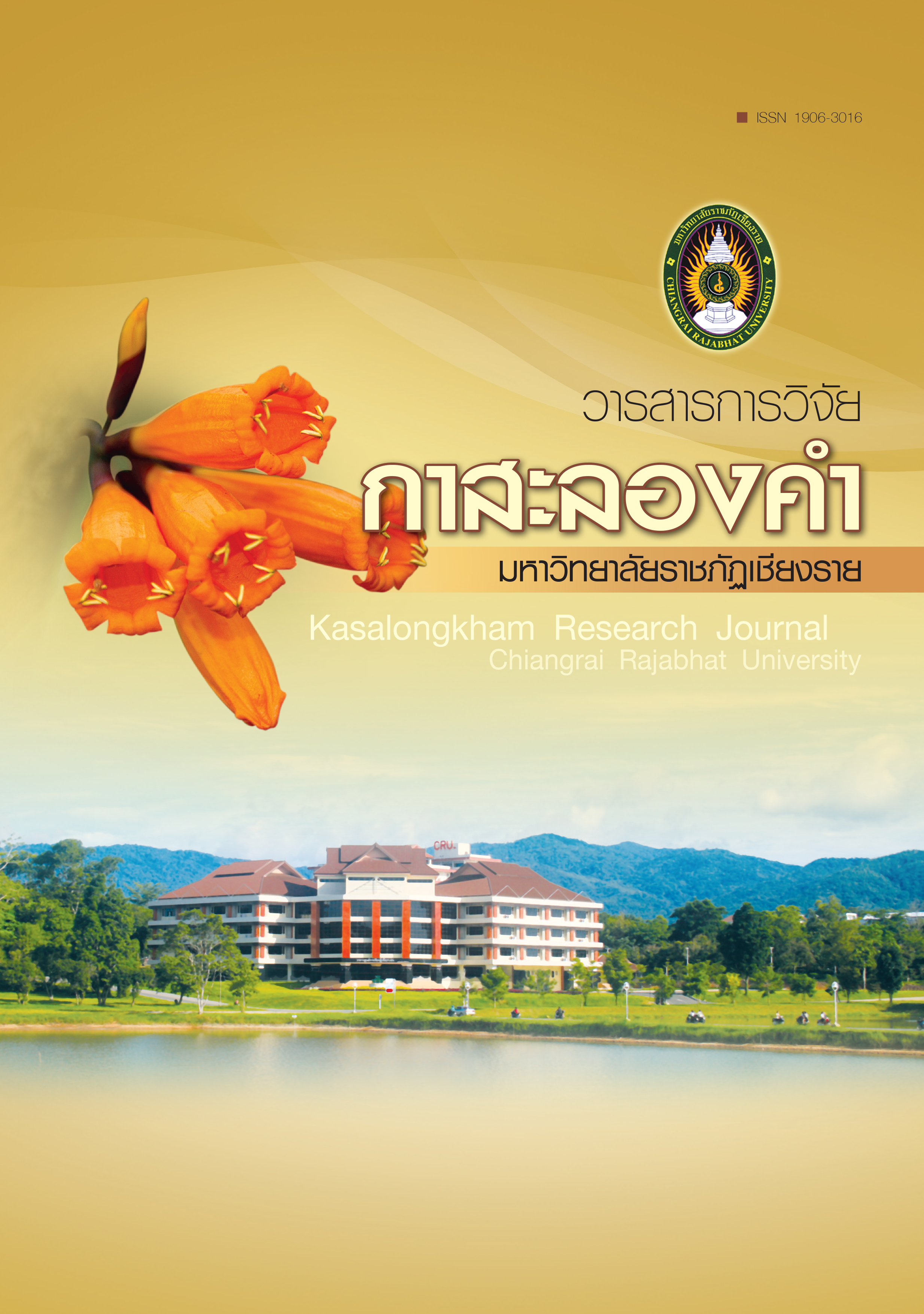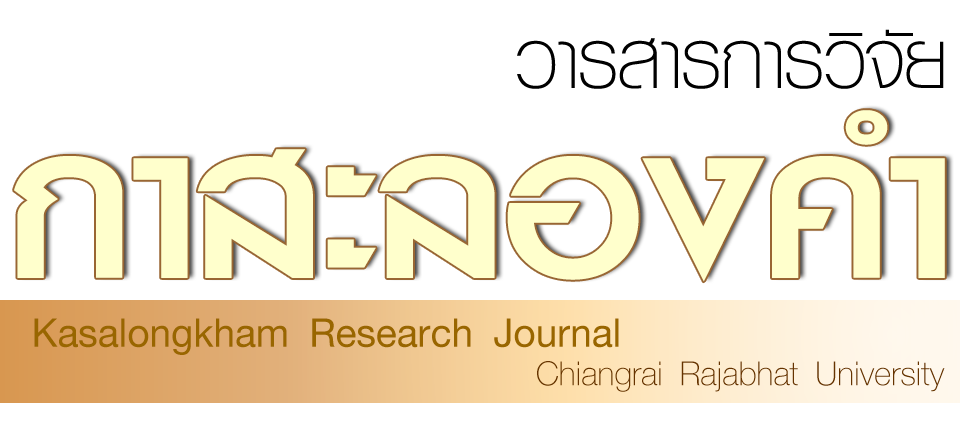การวิเคราะห์กลวิธีการแปลบทความทางวัฒนธรรม จากภาษาไทยเป็นภาษาอังกฤษของนิตยสารเมืองโบราณ
บทคัดย่อ
การศึกษานี้มีวัตถุประสงค์หลัก เพื่อระบุ และจัดกลุ่มกลวิธีที่ใช้ในการแปลภาษาไทยเป็นภาษาอังกฤษ
ของนิตยสาร “เมืองโบราณ” และค้นหาลักษณะโครงสร้างทางภาษาและคำศัพท์ทางวัฒนธรรมที่จูงใจ
ให้นักแปลภาษาใช้กลวิธีเหล่านี้ ข้อมูลได้มาจากบทความที่เป็นภาษาต้นและภาษาเป้าหมายในการแปลของ
นิตยสารเมืองโบราณ
ผลการศึกษาแสดงให้เห็นว่า มีกลวิธีการแปล 8 ชนิดที่ถูกใช้บ่อยในนิตยสารเมืองโบราณจากภาษาไทย
เป็นภาษาอังกฤษ กลวิธีเหล่านี้ประกอบด้วย การเพิ่ม การแทนที่ การใช้คำทั่วไป การเสริม การละ
การทับศัพท์ การเปลี่ยนรูปคำ และการเปลี่ยนรูปวลีและประโยค กลวิธี 3 อันดับแรกที่นักแปลใช้บ่อยที่สุดคือ
การทับศัพท์ 38.37%, การเปลี่ยนรูปคำ 12.79% และการใช้คำทั่วไป 10.47% มีลักษณะโครงสร้างทางภาษา
16 ชนิด แต่นักแปลใช้กับกลวิธีเหล่านี้แค่ 13 ชนิด เช่น ลักษณะนาม กาล และกรรมวาจก จุดประสงค์หลัก
ของการใช้กลวิธีการแปลที่มีผลต่อการใช้ลักษณะทางภาษาคือ การทำให้ถูกต้องตามหลักไวยากรณ์ และ
บทความที่ถูกแปลเป็นที่ยอมรับ มีคำศัพท์ทางวัฒนธรรม 8 ชนิด แต่นักแปลใช้แค่ 6 ชนิด กับกลวิธีเหล่านี้
เช่น การเรียกชื่อตามตำแหน่งหรืออาชีพ, นิเวศน์วิทยา และการเปรียบเทียบ จุดประสงค์หลักของการ
ใช้กลวิธีการแปลที่มีการใช้คำศัพท์ทางวัฒนธรรมคือ ช่วยให้ผู้ที่สนใจที่ไม่ใช่เจ้าของภาษา เข้าใจเนื้อเรื่อง
ได้ง่ายและชัดเจนยิ่งขึ้น
References
Items in Translation” Aixelá, J.F.
Baker, M. (1992). In Other Words. Routledge. London.
Baker, M. (2001). Routledge Encyclopedia of Translation Studies. Routledge, London.
Baker, M. (2005). Translation and Conflict. Routledge, London and New York.
Cambridge University. 2003. Cambridge Advanced Learner’s Dictionary. Cambridge : Cambridge
University Press.
Chantraket, C. (1985). Translation for Communication. Thaiwatanapanit, Bangkok. (in Thai).
Charnchairerk, C. (1999). Thai-English Translation for Mass Communication Students.
Chulalongkorn University Language Institute, Bangkok. (in Thai)
CR1R2 U วารสารการวิจัย กาสะลองคำ
Hatim, B. (2001). Teaching and Researching Translation. Pearson Education Limited, England.
Hatim, Basil and J. Munday. (2006). Translation an Advance Resource Book. Routledge,
London.
Korporsiripath, W. (2005). Translation: A Linguistic Approach. Mahasarakarm University
Press Mahasarakarm, (in Thai).
Larson, L. M. (1984). Meaning-Base Translation : A Guide to Cross-Language equivalence.
University Press of America, USA.
Mildred, L. (1984). Meaning Based Translation : A Guide to Cross Language Equivalence.
Lanham. University Press of America.
Minabad, H. (2004). Culture in Translation and Translation of Culture Specific Items. Translation
Studies. 5, 2. p. 31-46.
Newmark, P. (1981). Approaches to Translation. Pregamon Press, Oxford.
Newmark, P. (1988). A Text Book of Translation. Adab, Tehran.
Newmark, P. (1981). Approaches to Translation. Polytechnic of Central London, London.
Newmark, P. (1988). A Textbook of Translation. Prentice Hall, Singapore.
Nida, A. E. (1975). Language Structure and Translation. : Stanford University Press, Stanford.
Nipaporn, O. (2010). Thai-English Translation Strategies in “Being Thai” column in Kinnaree
Magazine. Chiang Mai University, Thailand.
Prachumporn, C. (2008). An Analysis of the Translated English Signboards in Chiang Mai.
Chiang Mai University, Thailand.
Saibua, S. (2007). Principle of Translation. 8th ed. Thamasat University Press, Bangkok.
Sangaramreung, W. (1999). Theory and Principle of Translation. Chulalongkorn University
Press, Bangkok, (in Thai).
Sarothai, L. (2004). Strategies Used in Documentary Translation : A Case study for National
Geographic Magazine. King Mongkut’s Institute of Technology North Bangkok, Thailand.
Suparada, E. (2009). An Analysis of Thai-English Translation of a Historical Movie:
The Case Study of The Legend of Suriyothai. Graduate School, Kasetsart University.
Wimolchalao, W. (1996). Handbook for Teaching Translation. 7th ed. Chulalongkorn University
Press Bangkok, (in Thai).





